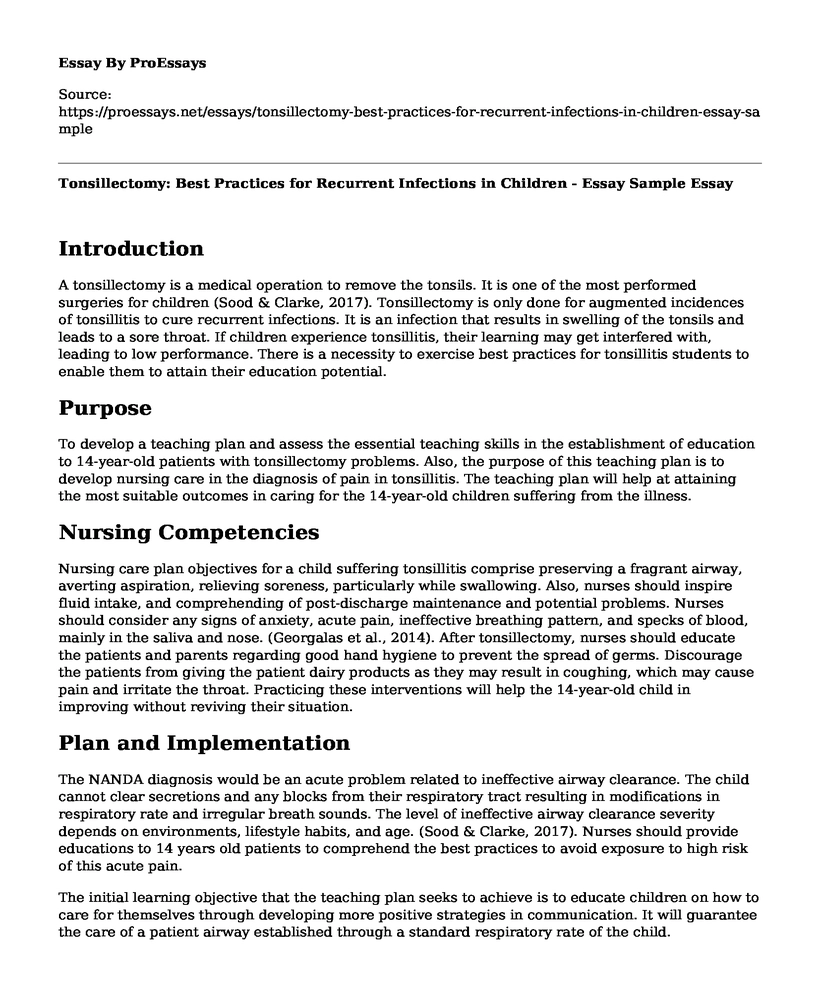Introduction
A tonsillectomy is a medical operation to remove the tonsils. It is one of the most performed surgeries for children (Sood & Clarke, 2017). Tonsillectomy is only done for augmented incidences of tonsillitis to cure recurrent infections. It is an infection that results in swelling of the tonsils and leads to a sore throat. If children experience tonsillitis, their learning may get interfered with, leading to low performance. There is a necessity to exercise best practices for tonsillitis students to enable them to attain their education potential.
Purpose
To develop a teaching plan and assess the essential teaching skills in the establishment of education to 14-year-old patients with tonsillectomy problems. Also, the purpose of this teaching plan is to develop nursing care in the diagnosis of pain in tonsillitis. The teaching plan will help at attaining the most suitable outcomes in caring for the 14-year-old children suffering from the illness.
Nursing Competencies
Nursing care plan objectives for a child suffering tonsillitis comprise preserving a fragrant airway, averting aspiration, relieving soreness, particularly while swallowing. Also, nurses should inspire fluid intake, and comprehending of post-discharge maintenance and potential problems. Nurses should consider any signs of anxiety, acute pain, ineffective breathing pattern, and specks of blood, mainly in the saliva and nose. (Georgalas et al., 2014). After tonsillectomy, nurses should educate the patients and parents regarding good hand hygiene to prevent the spread of germs. Discourage the patients from giving the patient dairy products as they may result in coughing, which may cause pain and irritate the throat. Practicing these interventions will help the 14-year-old child in improving without reviving their situation.
Plan and Implementation
The NANDA diagnosis would be an acute problem related to ineffective airway clearance. The child cannot clear secretions and any blocks from their respiratory tract resulting in modifications in respiratory rate and irregular breath sounds. The level of ineffective airway clearance severity depends on environments, lifestyle habits, and age. (Sood & Clarke, 2017). Nurses should provide educations to 14 years old patients to comprehend the best practices to avoid exposure to high risk of this acute pain.
The initial learning objective that the teaching plan seeks to achieve is to educate children on how to care for themselves through developing more positive strategies in communication. It will guarantee the care of a patient airway established through a standard respiratory rate of the child.
Children often experience difficulties when understanding tonsils and the process of removal. It is useful to deploy age-appropriate educational materials methodology to educate the child about tonsillectomy. Establishing learning experiences that range within the normal progressive parameters of a child enables a proper understanding of concepts through exploring, observing, listening, and asking questions (Gosalia, 2015). The instructional materials can provide knowledge to the child, such as:
- What is a tonsillectomy?
- What are tonsils?
- What happens after tonsillectomy?
It is essential to ensure that the children understand the concept of tonsillitis infections; it is vital to ask the above questions in a precise manner. Also, incorporating the age-appropriate educational materials should contain pictures to explain to the children about their conditions. The images should be presentable in a way that the child will not be scared. The questions should match the integrated pictures to give the child an understanding and memory of the information delivered.
Various resources will be required to enhance the learning of the child, such as accessing more educational websites regarding tonsillectomy. Also, using charts, media devices, and any teaching material that does not require the learner to use voice is substantial in advancing the knowledge of tonsils.
Evaluation
Pain-relieving can be assessed by the learner’s reduction in the anxiety during a tonsillectomy. Medics can provide psychological training to caregivers in minimizing pain. The child’s behavior can help assess the demonstration of interference methods (Sood & Clarke, 2017). Also, it is essential to establish a pleasant teaching environment for the children as a way of enhancing ample sleep while at home.
References
Georgalas, C. C., Tolley, N. S., & Narula, A. (2014). Tonsillitis. https://www.ncbi.nlm.nih.gov/pmc/articles/PMC4106232/
Gosalia, P. (2015). The importance of age-appropriate education. https://theswaddle.com/importance-age-appropriate-education/
Sood, S., & Clarke, R. (2017). Tonsillectomy in adolescents. https://www.entandaudiologynews.com/media/5477/entjf17-sood-clarke-new.pdf
Cite this page
Tonsillectomy: Best Practices for Recurrent Infections in Children - Essay Sample. (2023, Aug 22). Retrieved from https://proessays.net/essays/tonsillectomy-best-practices-for-recurrent-infections-in-children-essay-sample
If you are the original author of this essay and no longer wish to have it published on the ProEssays website, please click below to request its removal:
- Paper Example on Non-Profits: Working on Grounds of Charity?
- Essay Sample on Leadership as Necessary Component of Patient Safety and Care
- Essay Example on Older Adults: Mental Health Challenges & Health Promotion
- Teen Vaping: The Dangers Lurking Behind the Pleasure - Essay Sample
- COVID-19: From First Cases in China to Global Pandemic - Essay Sample
- Reflective Essay in Nursing: Examining Cultural Contexts
- Killing Nurses of the Third Reich: A Grim Reminder of Professional Ethics - Essay Sample







